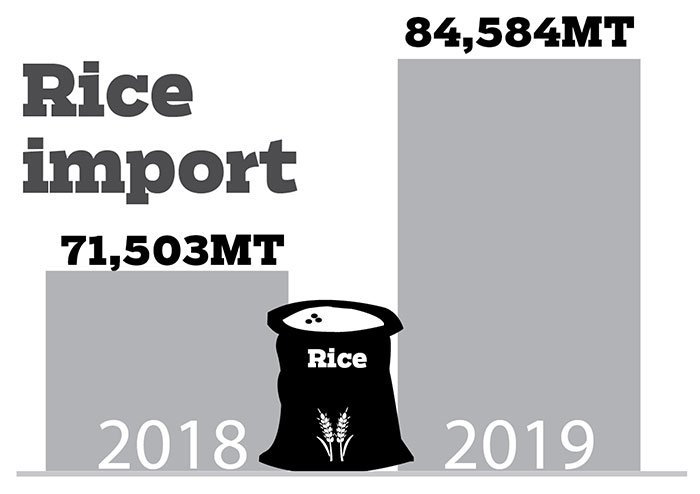MB Subba
Despite successive governments’ efforts to boost agricultural production over the years, the import of food products has increased.
The import of rice increased to more than 84,584 metric tonnes (MT) in 2019 from 71,503MT in 2018, according to annual RNR statistics. This is an increase by 18 percent.

Rice includes semi-milled rice, red and broken rice. Rice in husk and husked (brown) rice are mostly imported by industries.
The report is based on the analysis of import data sourced from Bhutan Trade Statistics, published by Department of Revenue and Customs. The volume and value of import of cereal by types from India during the period from January to December 2019 are compared with the same period of the previous year.
The import of cereals from countries other than India is negligible, according to the report.
The import of wheat and meslin increased to 4,891MT in 2019 from 3,071MT in 2018, an increase by almost 59 percent. Wheat and meslin include seeds and others of wheat and meslin.
The import of rye on the other hand also increased to 4.31MT in 2019 from 2.47MT in 2018, an increase by almost 75 percent. Rye is similar to wheat and is used for making flour and bread.
The import of maize decreased to 15,924MT in 2019 from 21,759MT in 2018, a decrease by almost 27 percent. Maize includes seeds and others of maize product.
The import of buckwheat increased to 122.09 MT in 2019 from 120.56 MT in 2018, an increase by 1 percent. Buckwheat includes seed of low imported volume and other buckwheat for consumption.
However, the import of other cereals decreased by almost 57 percent. The import of cereals decreased to 17MT in 2019 from 39MT in 2018.
This is attributed to an increased local production. According to the 2019 RNR census, the highest production among cereals is irrigated paddy and maize, respectively with 63,404MT and 55,254MT.
Other cereals grown in the country are buckwheat, wheat, millet, barley, quinoa and amaranthus.

